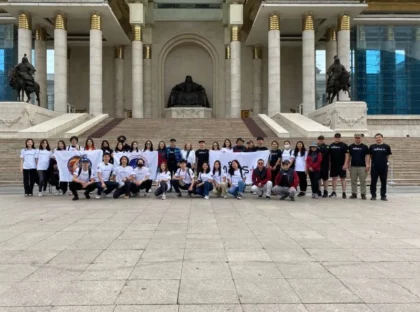
By Dr. Robert Zubrin, The Cosmopolitan Globalist, 07.13.22
While I earn my living as president of a small aerospace R&D company, Pioneer Astronautics, I also lead the Mars Society, a non-profit that promotes the exploration and settlement of Mars. Founded in 1998, the Mars Society has chapters in 40 countries. Our activities include public outreach to spread our vision, securing support for government Mars programs, and projects of our own—most notably, establishing Mars analog research stations in deserts around the world.
Their mission is to learn how to explore Mars by tasking a small crew, typically six scientists and engineers, to conduct a program of geological and microbiological field exploration while operating under as many Martian constraints as we can impose on them—for example, wearing spacesuits whenever they are outside. We’ve built a station in the Canadian high Arctic and another in the Utah desert. Since 2001, we’ve operated more than 250 crews in them for durations ranging from two weeks to three months. Some of our 1500-odd former crew members have gone on to establish other stations in Hawaii and Poland, and formed a very professional group, headquartered in Austria, that conducts such expeditions in locations across the Middle East. Our Australian chapter has launched an initiative to establish a station in a region of the Australian outback with bacterial fossils dating back to the origin of life on Earth—exactly the sort of thing astronauts will be searching for on Mars.
Inspired by this, a group of Mongolians formed their own organization, Mars-V, and asked me to come to Mongolia to advise and support their effort to build a Mars analog research station in the Gobi Desert. I expected Mars-V to be perhaps a dozen local Mars enthusiasts. Instead it turned out to be a highly influential organization with some three thousand members, including corporation and bank presidents, prominent cultural figures, political party leaders, and Mongolian government cabinet members.
Erdenebold,[1] At 39, is one of the leaders of Mongolia’s Democratic Party, which has a free-enterprise bent. He is friends, though, with much of the cabinet of the ruling People’s Party, which leans social-democratic and of whom some are members of Mars-V. Erdenebold has a degree from Harvard Law, served as a major in a Mongolian Army unit alongside American forces in Afghanistan, and has written ten books, including a modern Mongolian verse translation of The Secret History of the Mongols.[2] He met us at the Ulaanbaatar airport, waving us past customs and immigration, joined by his close associate Munkhnast (“Everlasting”) and 30 Mars-V members sporting Mars-V and Mars Society banners. We caravanned together to the city with an honorary police escort, where they put us up in the excellent, if sparsely patronized, Shangri-La Hotel.[3]
Ulaanbaatar has been called the most air-polluted city in the world, but the air was fine. The problem isn’t the prominent coal-fired power plant that provides electricity to the city year round, it’s the use of coal in domestic fireplaces to heat homes in the winter. The Chinese offered to help solve this problem by building a hydroelectric dam, but this was blocked by the Russians, who compete with the Chinese for influence and market share within the country. What Ulaanbaatar could really use is a midsized—say 600 MW—nuclear power plant. (Korea, are you listening?)
We met the next morning in the city’s central square, dominated by a huge statue of Chingis Khan. A more modest statue of Marco Polo stands across the street. Chingis is a hero to Mongols, a kind of founding father. While Mongols had existed thousands of years before him, it was he who united the constantly warring tribes and suppressed the endless inter and intra-clan violence, replacing the anarchy with a uniform and rational set of laws, including such attractive features as universal religious toleration, the abolition of torture, and a sharp reduction in the number of capital offenses. He also suppressed brigandage, making long-distance trade possible across all his domains, and amplified the resulting prosperity by introducing paper money—a Mongol invention. Combined with the organization of Mongol horse-archer war-fighting methods into a powerful military system, this gave Chingis a nearly unstoppable carrot-and-stick in foreign policy tool that within a generation created an empire covering most of Eurasia.
Cities were offered a choice: friendly annexation to his prosperous regime or futile resistance. Most chose annexation, thereby adding their capabilities (such as siege craft engineering) to the Mongol forces. Those who resisted were almost always defeated, after which Chingis would execute the ruling aristocrats but preserve the useful classes—including merchants, artisans, and farmers—to add power to his empire.[4]
Things went a bit haywire after Chingis’s death, when his empire was divided among his four less worthy sons. Building upon Chingis’s invention of paper money, they proceeded to invent hyperinflation, making the currency worthless. Still, the interlinked Mongol empires continued to grow and prosper, so that in the late 1200s, when the Italian traveler Marco Polo visited the Sinocentric domain of Chingis’s grandson, Kublai Khan, he described it as a world of unmatched wonders.[5]
Other Mongol inventions included the stirrup, playing cards, and most importantly, printing, using movable type. The Chinese had invented printing using carved blocks of characters, but the Mongols had an actual alphabet of some 41 letters, which made movable, reusable type printing possible. They also invented yogurt, and introduced words such as “hurrah,” which, as Erdenbold pointed out to me, was used extensively in many American Civil War songs, including Union Forever, Marching Through Georgia, and The Bonnie Blue Flag.
But the Mongols’ most important cultural legacy was not their own inventions, but the extensive trade networks they established. These acted as a transmission belt for innovation, bringing together the inventive capabilities of previously separated civilizations. The main beneficiaries were the Europeans, who were far more open to the ideas of outsiders than their counterparts in Islamic, Indian, and Chinese societies. In 1600, Francis Bacon listed printing, gunpowder, and the compass as the three inventions that had revolutionized the world. All had been transmitted to Europe by the Mongols.
The same routes also carried the Black Plague, which emerged in south China and spread globally along Mongol trade routes, in the process shutting down the very trade upon which Mongol commercial power was based. Fatally weakened, the Mongol empires were overthrown or driven back by local powers in China, Russia, and the Middle East. Even their homeland was ultimately dominated, first by China and then by Soviet Russia. The Soviets gave Mongolia its current Cyrillic alphabet and some good technical institutes, but imposed a brutal Stalinist dictatorship, murdering, among many others, some 40,000 Buddhist monks. One of Mongolia’s early Marxist leaders tried to reject this purge, and actually slapped Stalin in the face. He paid for his defiance with his life.
To read the full article by Dr. Zubrin, please click here.


